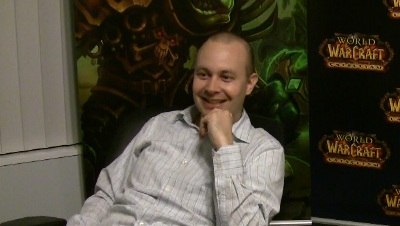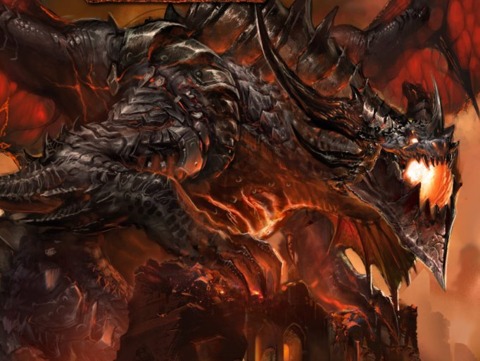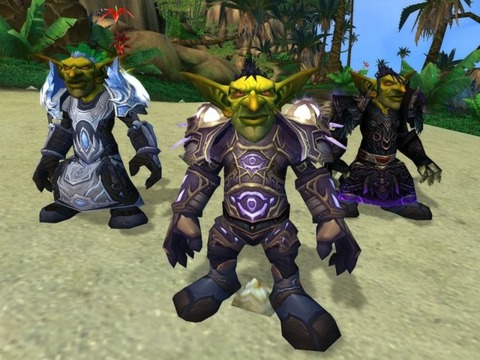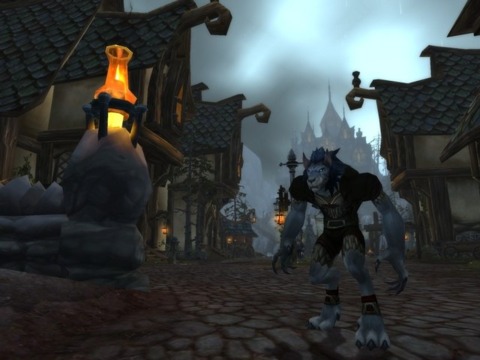World of Warcraft after the Cataclysm
Q&A: Game director Tom Chilton discusses Blizzard's reaction to the arrival of MMORPG's third expansion, suggests fans won't have to wait two more years for number four.
Last Tuesday, Blizzard Entertainment flipped the switch on Cataclysm, the third expansion to its phenomenally successful massively multiplayer online role-playing game World of Warcraft. Like wildfire, the game spread to more than a dozen regions and set a new all-time PC sales record, selling more than 3.3 million units in 24 hours. Of course, with Blizzard already boasting more than 12 million active and engaged users, it'd have been more of a surprise had a record not been set.

As could be expected from the two-years-in-the-making expansion, Cataclysm was accompanied by a host of new features to WOW. Chief among the changes is the total overhaul of the in-game environment. Azeroth has been ravaged by the return of the ancient dragon Deathwing, and popular locales have been drastically altered, making the old new again. The expansion also ups the level cap to 85 and adds two new races: Goblins and Worgen.
To get a look at the game's launch from within Blizzard, GameSpot caught up with World of Warcraft game director Tom Chilton. As part of the interview, Chilton discussed the costs of introducing new classes and races to the game, why the Draenei and Blood Elves were seemingly passed over by Deathwing, and how The Shattering ushered in Cataclysm. He also noted that WOW fans probably won't have to wait two more years for the MMORPG's next major add-on to arrive.
GameSpot: Cataclysm's out, congratulations. The game sold 3.3 million units in 24 hours. What's the sentiment around the office?
Tom Chilton: I think a lot of relief that we've finally burst this whale. People are generally in high spirits. It's funny because what's fairly normal when we launch an expansion is the company goes into a craze of playing the game. We go into game-player mode, where we're all playing the game, and every morning, we're all in each other's offices talking about what we did the night before.
GS: As to the actual sales number, is there any indication whether most of those sales came from people who are currently playing or returning to the game?
TC: I don't have any data on that yet. I really don't know.
GS: Let's see. Do you have any data on how digital sales went?
TC: I know we do have data, but we're not making it public yet.
GS: OK, so to the actual shipping of the expansion itself. Any key takeaways?
TC: For sure. There was a ton of complexity in the whole process of switching over from the old world to the new world. Fortunately, it was probably a one-time kind of thing for us. It definitely caused its share of development problems--a lot of tricky technical stuff to negotiate. So that's something I think we'll be very careful about going into. But we've learned some lessons if we do that kind of thing in the future.
Aside from that, there are all the lessons about the zones themselves, and the questing and quest flow and the linearity versus storytelling versus freedom to do what you want versus how we use phasing and grouping dynamics, and all that kind of stuff. Overall, we're very happy with how it's gone. We definitely used some of our tech a lot more than we've ever used before, at least as it relates to phasing and stuff like that. We're going to continue to learn lessons, like when [is] the best time to use that and how to best take advantage of it.
GS: How work intensive was creating this expansion compared to The Burning Crusade and Wrath of the Lich King?

TC: Definitely a larger work investment than anything we've done in the previous expansions. We tried to mitigate that somewhat by splitting our time between old world zones and the new zones that we added. That's part of why we had five levels instead of 10. We really felt like we wanted to split our efforts on the level-design front and quest-design front into two different parts of the game. But the redoing of the old world ended up being a much bigger endeavor than we originally planned.
We originally planned to not do as big of a revamp as we ended up doing. Because in some ways, in our minds, some of the old content was better than it actually was. And then when we went back to actually doing it, we found that even the content that we thought was pretty close still wasn't even very close, so we ended up doing a much more significant revamp than we originally planned. More than anything else, I'd say that's what upped production costs.
GS: Looking forward, do you see future expansions being just as work intensive? Or do you plan to scale them down? How do you think that will play out?
TC: I definitely think that two years was longer than we'd like to see for how long it takes to get an expansion into the hands of players. On this one, we're willing to accept that and feel like we did the right thing because we're trying to make the right long-term decision for the game in terms of the quality of the level 1-60 content. But going forward, since we've already bitten that bullet, we're going to try to hit a better pace. Exactly what that pace might be, I don't know, but I'd definitely like them to hit more quickly than what we've done in the past.
GS: You've said something along the lines of an expansion a year. Is that still the target?
TC: That would be probably really close to ideal in my mind. I don't know that we have the capability to do that. Maybe if we stopped doing content patches completely and just went straight from expansion to expansion, I think we would be able to do that. But we're still committed to doing content patches, and I think that in some ways makes nailing [every] year infeasible, at least for now. So somewhere in between [a year and two].
GS: So, you've destroyed the old world. What are some of the ideas for where things can go next?
TC: Oh, wow. We have all kinds of ideas of where to go next. Some of these ideas have been brewing for a long time. We're currently in the planning stages for not only our upcoming content patches--we pretty well have a very good idea of what we're doing for our 4.1 content patch--but for the next expansion even, we're doing our planning for that. I don't have any details to talk about yet, but there are a number of different ideas that have been floating around for a while that we can pick and choose from and try to decide which one is the right one for the game in the next couple of years or so…what we think really hit home the most and would be something that we can get really excited about.
GS: In this expansion, you introduced two new races and no new classes. Do you like how that played out? Have you intentionally broken up expansions so that in one you'll introduce races and in another you'll do classes?

TC: It's something we think about. It's funny because the costs are very different, in terms of production costs versus game design and game-health costs, between races and classes. What we've found is that classes don't have as high of a production cost, but they have a massive game-health cost. You can really damage the game by adding a new class and not doing it well, but it's hard to damage the game by just adding new races. There's not that much behind a race other than the assets, the zones, the content itself, and the racial abilities, which are relatively minor. It's hard to break the game by adding races. You can break your [development] team by committing to doing races, but the game itself, it's a lot harder to endanger.
We have to pick and choose very carefully. We know there's no way we can do a class with every expansion because we would break the game at some point. There are a finite number of classes that the game can support before the game mechanics are just too contrived and they're all overlapping. We definitely don't think we've hit that point yet, but there's no way that we can add a class with every expansion.
GS: One more general question. There's been a purported Blizzard release schedule floating around the Internet, indicating the next expansion will arrive in Q2 2012. Utterly fabricated? Uncomfortably accurate? No comment?
A Blizzard PR Representative: We don't comment on rumors or speculation.
GS: Fair enough. Getting to the game itself, before Cataclysm launched, you had this free update, The Shattering. Was that always intended to be a free update? Or was it originally designed as part of the Cataclysm expansion?
TC: That was absolutely designed to be a free update. We knew right from when we first started designing [Cataclysm] that there was no way we were going to split our player base into two, effectively--people that bought the expansion and people that didn't buy the expansion--and have them playing totally different games. All the stuff that directly related to redoing content that already existed--that players already had access to--was stuff that we felt like, well, we're just going to give that away and we're going to take it on faith that we're still doing enough new stuff that it makes for a compelling product that people would want to go out there and get.
GS: What impact do you think The Shattering had on getting players to buy Cataclysm?
TC: I would like to say that it was significant, but I don't have any kind of data to back that up. I don't know who's buying Cataclysm yet, presumably it's mostly players who are playing or have played the game. My gut is that The Shattering definitely built up a really big event to talk about. We knew going into it that one of the things it would do is light the nostalgia of having played World of Warcraft in the past…whether or not it was for somebody who is still a subscriber today or someone who had played the game in the past and had a good time but felt like they'd been there and done that…seen it all. We felt like it would reignite that sort of nostalgia for them, too. So we definitely felt like that was a very core part of the expansion and very integral to its overall success.
GS: Cataclysm impacts nearly all of Azeroth, but there was little to no change to the Draenei and Blood Elf content. What was the thinking there?

TC: The real answer is that, more than anything else, that was a bang-for-the-buck decision. Players spend very little time in that area, so it didn't make a whole lot of sense going about redoing it. Also, that area was already at a higher quality level than the old world was because it was done for Burning Crusade, with Burning Crusade techniques and with everything we'd learned from launching the game the first time around. So it was already better off than the old content was. And anyone who makes a new Blood Elf or Draenei, they're out of there by level 10, and pretty much no one is going back to those areas these days. That content just isn't super relevant.
So, bang-for-the-buck wise, it just didn't make a whole lot of sense. And then we like to rationalize it in lore terms by saying, "Well, you know, if the people aren't there, why would Deathwing bother to go there to terrorize them?"
GS: So a few other things. Deadmines and Shadowfang Keep have been given new "heroic" versions. Why these two?
TC: Those two were for a couple reasons. Number one, they were fairly central to zones that we were doing significant revamps of. So with Westfall, we did this major change that kind of evolved the Defias Brotherhood storyline, and it wouldn't have made a whole lot of sense to have Deadmines stay exactly as is and not have some form of evolution. The same could be said for Shadowfang Keep. There were a lot of changes in Shadowfang Keep going on, what with the introduction of the Worgen as a playable race, and Shadowfang is a very Worgen-centric dungeon, so we wanted everything to stay cohesive.
The next thing is that those are a couple of the fan favorites. Those are ones that players have enjoyed in the past a lot, and we just felt like that would be a cool bit of nostalgia to go back to.
GS: Do you think you'll do something similar for other dungeons?
TC: Yeah, we do have hopes to do it for other dungeons. We'll see what actually works out, but we definitely have other ideas in mind.
GS: Let's see, I just have one more question. The community took up arms over the game's guild-leveling system after it was changed a couple of days after Cataclysm came out. Was it that big of a concern for you guys that guilds were leveling too quickly? Why wasn't this issue identified in beta?
TC: There's a couple of things in play. It's not just the speed of leveling; it's also what the experience is like while you're leveling. If you're the guy that's logging on at, let's say, 5:00 p.m., and your guild is already capped out on experience for the day because of the tuning, then that whole aspect of the system feels kind of pointless. It feels like the guild is just magically going up in level on its own because some of the guys earlier in the day had easily capped it out way too quickly. So that was our rationale for tuning down the returns people were getting from quests. People were doing quests at an incredibly high rate, and it just wasn't quite tuned right, I would say.
And then on the achievement point side, we definitely want for players to have ways to distinguish their guild from other guilds, and we have a slightly different plan for how we're going to do that, at least in terms of gaining experience. Essentially, what's going to happen is that as the guild level increases, the caps will get more and more forgiving, to the point where you effectively don't have a cap, so that the pace of guild advancement feels reasonably steady early on, and it feels like different guilds, regardless of size or hardcore-ness, are keeping up with each other reasonably. But then, as we get further out and closer to guild level 25, those guilds start to create more and more separation, so that the hardcore have a chance to be the first ones there, but not by the massive margin that they would be if there were no limitations.
As for why some of this didn't get seen in beta, we deliberately tuned the advancement rates to be much higher than normal, so the advancement rates being high in beta didn't surprise us. We had cranked up those values because we just wanted people testing things out and seeing that everything actually worked. And since guilds don't really behave the way guilds normally do in beta, it's very difficult to get any real data about behavior from beta that actually applies to the live game.
GS: Do you think there are more changes in store for this?
TC: Yeah, there will be more changes, in that one of our small interim patches, basically one of our bug-fixing patches, is coming up. We have plans to have that cap become more and more forgiving as your guild goes up in levels so that the hardcore have a chance to shine later on down the line.
Metaphor: ReFantazio The King’s Trial Trailer Tales of the Shire - Official Announcement Trailer Dead Island 2 – Steam Launch Trailer Nickelodeon All-Star Brawl 2 - Official Zuko Gameplay Spotlight Trailer Valheim: Ashlands - Official Gameplay Trailer Tales of Kenzera: ZAU GameSpot Video Review Stellar Blade - Beta Skills Gameplay Trailer | PS5 Games Stellar Blade - Burst Skills Gameplay Trailer | PS5 Games GODDESS OF VICTORY: NIKKE | New Main Chapter 29~30 Update Trailer GODDESS OF VICTORY: NIKKE | Happy 1.5 Anniversary Trailer GODDESS OF VICTORY: NIKKE | Kilo Character Motion Demonstration Trailer How The Fallout TV Show Shapes Fallout's Future
Please enter your date of birth to view this video
By clicking 'enter', you agree to GameSpot's
Terms of Use and Privacy Policy
Got a news tip or want to contact us directly? Email news@gamespot.com
Join the conversation